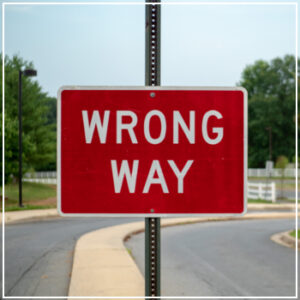Imagine you’re driving home after a long day of work when suddenly, a car driving in the opposite direction is headed right toward you. You react as quickly as you can, moving out of the way for the motorist – but not every driver is as lucky. Wrong-way driving makes up a small percentage of all motor vehicle accident statistics, but it has one of the highest fatality rates of all potential causes.
What’s Wrong-Way Driving?
 These crashes happen when a driver goes in the opposite direction of the traffic flow. The National Highway Traffic Safety Administration’s definition applies to crashes on controlled-access highways only and does not factor in crashes related to median crossovers. These instances include:
These crashes happen when a driver goes in the opposite direction of the traffic flow. The National Highway Traffic Safety Administration’s definition applies to crashes on controlled-access highways only and does not factor in crashes related to median crossovers. These instances include:
- A driver getting onto the wrong entrance ramp, going against the direction of the traffic.
- A driver turning onto a one-way street – common in urban areas.
- Driving on the wrong side of the road or highway, perhaps the result of getting off the wrong exit, not seeing a “one way” sign or making a wrong turn.
Yearly, roughly 350 individuals die from wrong-way driving accidents, making up three percent of the total. Although this number seems small, the probability rate of fatality is 1.34 per crash versus 1.1 for the typical accident, according to figures from the National Transportation Safety Board. As a result, wrong-way accidents are some of the most dangerous situations on the road.
How Wrong-Way Driving Happens
In the majority of cases, these accidents can be attributed to human behavior, rather than outside factors.
Driver Age
The NTSB conducted a study to examine data involving wrong-way accidents for common trends. In general, older drivers – specifically, individuals 70 and older – got into the largest percentage of crashes. Although there’s no direct correlation between age and accidents, researchers speculate that deteriorating eyesight makes it harder to read signs, thus increasing the chances a driver travels in the wrong direction.
Time of Day
The NTSB’s data indicated that wrong-way collisions frequently occur at night – the time exhausted, intoxicated drivers are out on the road and darkness decreases the visibility of essential signage. Specifically, nearly 80 percent of all wrong-way crashes occur between 6 p.m. and 6 a.m., and frequently fall on the weekend.
Drunk Driving
Anywhere from 50 to 75 percent of drivers at fault for wrong-way crashes are intoxicated. Those stopped by police had a BAC of at least .15 – twice the legal limit.
Poor Driving Behavior
When a driver is unfamiliar with an area, is not paying attention behind the wheel or gets distracted by a passenger, he or she might start to travel in the opposite direction. These behaviors may look like:
- Entering an exit ramp.
- Traveling in the opposite direction on the lane closest to the median.
- Being distracted by your phone, radio, food or passengers.
- Taking the wrong road or driving the wrong way on a one-way street.
- Ignoring signage.
Poor Traffic Design
Yet, drivers don’t always bear the brunt of the blame. Instead, poor traffic design where drivers can’t understand the signage may be behind frequent crashes:
- A sign is not visible or can’t be read.
- Signage is missing.
- Poorly placed or located signage.
- Ramps aren’t clearly marked.
- Ramps leading to a highway look like a two-way street.
- Cloverleaf interchanges can confuse some drivers, especially those who aren’t paying attention. As such, they end up on the wrong ramp, in the wrong lane.
- Ramps that require turning to the left to enter.
To combat these factors, cities have instituted various measures to help drivers, including:
- Thermal cameras on off-ramps and certain stretches of interstate highway. When these cameras detect a wrong-way driver, they flash a large “Wrong Way” LED sign. At the same time, these systems track the errant driver and alert law enforcement.
- Adding extra wrong-way signs, raised markers and pavement arrows to off-ramps.
- Placing signs closer to eye level, so drivers don’t have to strain or angle their head.
When these incidents occur, injuries are often similar to those sustained in head-on collisions. Victims frequently require surgery and extensive rehabilitation for their injuries, which may include:
- Broken bones
- Whiplash
- Head injuries
- Chest, abdomen and rib injuries
- Brain injuries, such as a TBI
- Full or partial paralysis
Were you the victim of a wrong-way driver and now your life is irreversibly changed? Rather than accept the situation or deal with an insurance company that places blame on you, work with Trantolo & Trantolo to get the compensation you deserve. To speak with a car accident lawyer, give us a call today.


